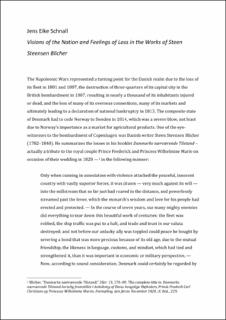Visions of the Nation and Feelings of Loss in the Works of Steen Steensen Blicher
Original version
In: Anna Bohlin, Tiina Kinnunen, Heidi Grönstrand (Eds.). Nineteenth-Century Nationalisms and Emotions in the Baltic Sea Region. 50-79 https://doi.org/10.1163/9789004467323Abstract
The Danish writer Steen Steensen Blicher was an outstanding and influential voice of the Biedermeier period, known for stories such as The Robber’s Den (1827), The Rector of Veilbye (1829), and The Hosier and His Daughter (1829). In his political writings, Blicher takes up the nationalist discourses of his time and focusses on a variety of related issues, such as Danish identity and cultural history, Danish language and dialects, the loss of territory after 1814, the Schleswig-Holstein question, and pan-Scandinavism. Both in Blicher’s poetic and political works, the themes of loss, change, and alienation are highly prominent. This chapter focusses on negotiations of feelings of loss within discourses on cultural history and on national and regional identities. The chapter shows how this thread evolves and develops from Blicher’s early works onwards. He deals with Danish history, heroes of the old, local traditions, and folktales and does so in an elegiac tone informed by Ossianism and the Nordic sublime – the portrayal of the distant national past is in itself a tale of loss of origin and unity. In his construction and imagination of communities, Blicher shows a mythicised and culturally loaded landscape, nostalgic utopias, ideals of lost homogeneity, and political visions of the Danish composite state and a united North.
